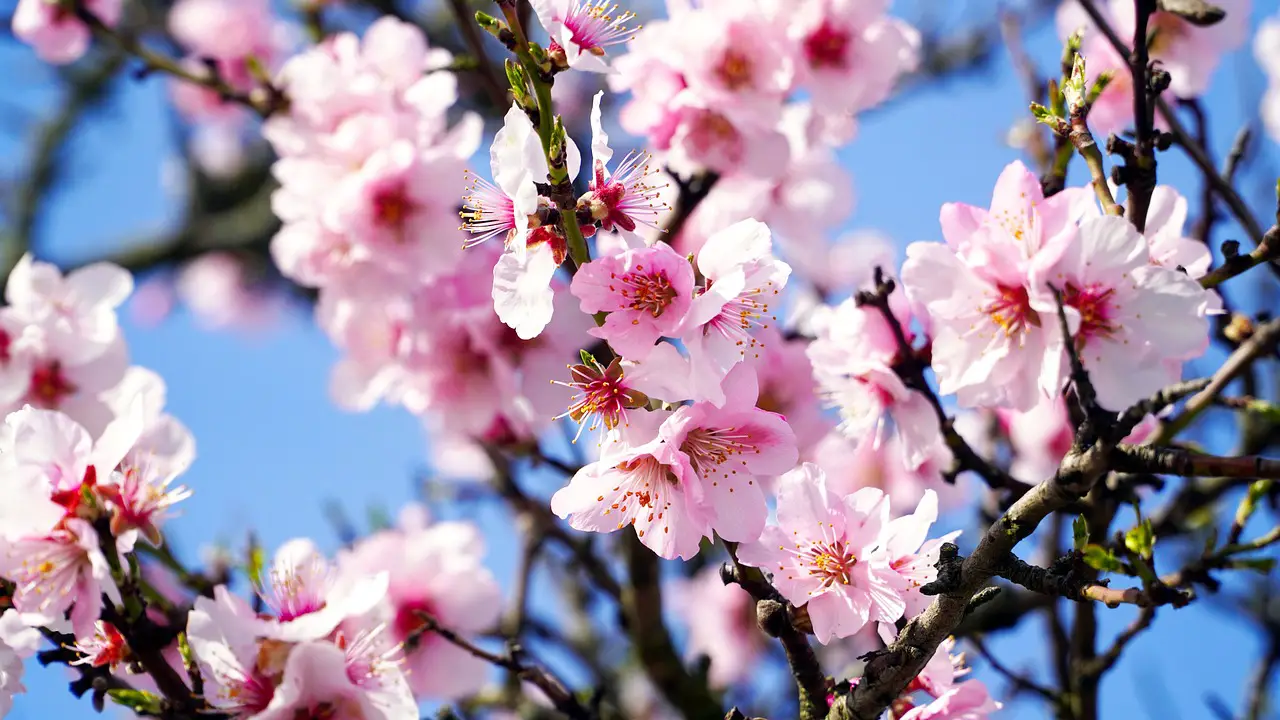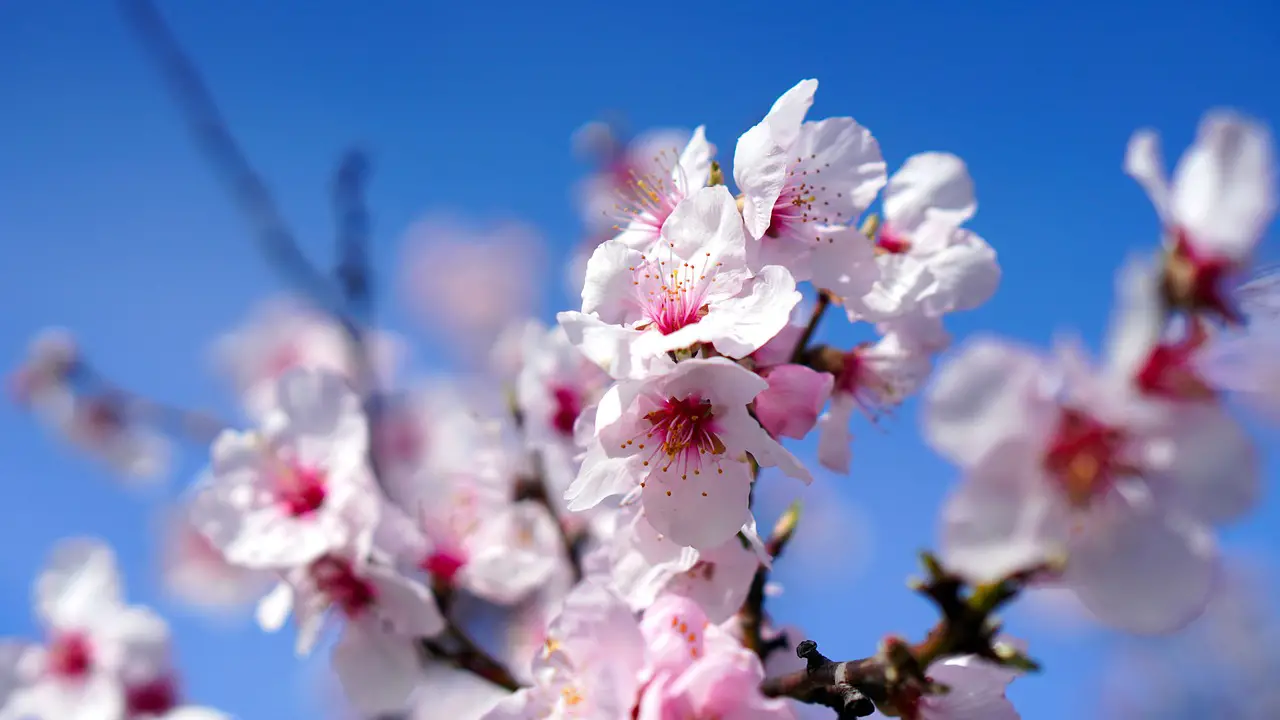The almond tree blossoms are a symbol of renewal and hope. Their delicate pink and white flowers emerge in early spring, representing the promise of new beginnings and the beauty of nature. The flowering process is not just visually stunning; it carries deep cultural and emotional meanings across various societies.
Understanding the Almond Tree
The almond tree, scientifically known as Prunus dulcis, is a deciduous tree native to the Middle East. It thrives in warm climates and is cultivated primarily for its nutritious nuts. Almonds are not only popular as a snack but also play a significant role in various culinary traditions around the world. The tree itself can grow up to 10 meters tall and features beautiful blossoms that attract pollinators such as bees.

The almond tree has a rich history, dating back thousands of years. It has been revered in various cultures for its beauty and the nourishment it provides. In many traditions, almond blossoms symbolize hope, awakening, and the cycle of life. The fleeting nature of the flowers reminds us of the transient quality of beauty and existence.
The Process of Blooming
The blooming of almond trees typically occurs in late winter to early spring. This timing may vary depending on geographic location and climate conditions. The process begins with the emergence of buds that gradually open to reveal stunning flowers. These blossoms can be white or shades of pale pink, creating a breathtaking sight against the backdrop of clear blue skies.
During this blooming period, several environmental factors play a crucial role:

- Temperature: Almond trees require a certain number of chill hours during winter for optimal blooming.
- Sunlight: Adequate sunlight is essential for photosynthesis and overall tree health.
- Soil Quality: Well-drained soil enriched with nutrients supports healthy growth and flowering.
Cultural Significance of Almond Blossoms
Across various cultures, almond blossoms hold significant meanings. In many parts of Asia, they symbolize purity, hope, and new beginnings. This symbolism is particularly evident during festivals celebrating spring and renewal.
In Jewish culture, the almond tree is mentioned in biblical texts. It is often associated with the promise of God’s protection and blessings. The blossoming of almonds signals the end of winter and the arrival of spring, embodying themes of rejuvenation and divine favor.
In art and literature, almond blossoms have inspired countless artists and writers. The delicate beauty of these flowers serves as a metaphor for love, beauty, and the fleeting nature of life. Van Gogh famously painted almond blossoms, capturing their essence and significance in his artwork.

The Nutritional Benefits of Almonds
Beyond their aesthetic appeal, almonds are highly valued for their nutritional benefits. They are rich in healthy fats, protein, vitamins, and minerals. Some key nutritional components include:
| Nutrient | Amount (per 100g) |
|---|---|
| Calories | 579 |
| Protein | 21g |
| Fat | 49g |
| Carbohydrates | 22g |
| Fiber | 12g |
| Vitamin E | 25mg |
This nutritional profile makes almonds an excellent choice for promoting heart health, supporting weight management, and enhancing overall well-being. Their antioxidant properties also contribute to protecting the body from oxidative stress.
The combination of beauty, cultural significance, and health benefits makes the almond tree and its blossoms a fascinating topic worthy of exploration. As we delve deeper into their meaning, we will uncover more about their role in different cultures and the broader implications they hold in our lives.
The Life Cycle of the Almond Tree
The life cycle of the almond tree is a fascinating process that reflects its resilience and adaptability. From seed germination to full maturity, each stage is critical for producing the beautiful blossoms and nutritious nuts that are so valued. Understanding this cycle provides insight into how these trees thrive in various environments.

Germination and Early Growth
The life cycle begins with the germination of seeds. Almond seeds require specific conditions to sprout, including:
- Soil Moisture: The soil must be moist but not waterlogged.
- Temperature: Ideal temperatures range from 60°F to 70°F.
- Chill Hours: Almonds need a certain number of chill hours during winter to break dormancy.
Once these conditions are met, the seed absorbs moisture and swells, eventually cracking open. The root emerges first, followed by the shoot, which will grow into the tree. This initial growth phase is crucial for establishing a strong foundation.
Maturity and Blooming
After several years, usually around three to four, the almond tree reaches maturity. This is when it begins to bloom and produce flowers. The blooming period is influenced by environmental factors such as:
- Spring Weather: Warm temperatures encourage blooming, while frost can damage flowers.
- Pollinators: Bees and other pollinators play a vital role in fertilization during this time.
The flowers of the almond tree are not only beautiful but also essential for fruit development. After pollination, the flowers develop into green fruits, which will eventually ripen into almonds.
Symbolism in Different Cultures
Almond blossoms carry deep symbolic meanings across various cultures. They are often associated with themes of hope, renewal, and love. Let’s explore some specific interpretations from different traditions:
Middle Eastern Significance
In Middle Eastern cultures, almond blossoms symbolize fertility and new beginnings. They are often celebrated during spring festivals, where their beauty represents the arrival of warmer weather and the end of harsh winters. In some traditions, they are seen as a sign of divine blessing.
Asian Cultures
In many Asian cultures, almond blossoms hold a special place in art and literature. They symbolize purity and beauty, often depicted in paintings and poetry. The fleeting nature of their blooms reminds people of the transient beauty of life.
Western Associations
In Western cultures, particularly in Jewish tradition, the almond tree is mentioned in biblical texts. It is associated with alertness and watchfulness, symbolizing God’s protection over His people. The blossoming of almonds is celebrated during various religious festivals, emphasizing renewal and hope.
Environmental Benefits of Almond Trees
Beyond their beauty and cultural meanings, almond trees play a significant role in promoting environmental health. Some key benefits include:
- Biodiversity: Almond orchards provide habitats for various wildlife, including birds and beneficial insects.
- Soil Health: The deep roots of almond trees help prevent soil erosion and promote soil fertility.
- Carbon Sequestration: Like other trees, almond trees absorb carbon dioxide from the atmosphere, contributing to climate change mitigation.
This ecological perspective highlights the importance of preserving almond trees not only for their fruits but also for their contributions to sustainable ecosystems.
The Economic Impact of Almond Cultivation
The cultivation of almonds has significant economic implications. It provides livelihoods for farmers and contributes to local economies. Here are some key aspects of its economic impact:
- Job Creation: Almond farming creates jobs in agriculture, processing, and distribution.
- Global Trade: Almonds are exported worldwide, making them a valuable commodity.
- Sustainability Initiatives: Many almond producers are adopting sustainable farming practices that enhance productivity while protecting the environment.
The almond industry’s economic benefits extend beyond agriculture, influencing related sectors such as marketing, food production, and tourism.
This multifaceted exploration of the almond tree’s life cycle, cultural significance, environmental impact, and economic contributions further enriches our understanding of this remarkable species and its blossoms.
Almonds in Culinary Traditions
Almonds are not only prized for their nutritional benefits and beautiful blossoms; they also play a significant role in culinary traditions around the world. Their versatility allows them to be used in various forms, including whole, sliced, or ground into flour. This section explores the diverse ways almonds are incorporated into global cuisines.
Sweet and Savory Dishes
Almonds can add flavor and texture to both sweet and savory dishes. Their rich, nutty flavor enhances a variety of recipes. Here are some popular culinary uses:
- Sweet Dishes: Almonds are often used in desserts such as cakes, cookies, and pastries. Almond flour is a popular ingredient in gluten-free baking, while marzipan, a sweet almond paste, is a favorite for decorating cakes.
- Savory Dishes: In Mediterranean and Middle Eastern cuisines, almonds are frequently added to rice dishes, salads, and tagines. They can be used whole, slivered, or toasted to enhance flavor and provide crunch.
Almond milk is another popular product derived from almonds. It serves as a non-dairy alternative to milk and is widely used in smoothies, coffee, and cooking.
Cultural Significance in Food
In many cultures, almonds are associated with special occasions and traditional celebrations. For example:
- Chinese New Year: Almonds symbolize good fortune and are often included in festive dishes.
- Weddings: In some cultures, almonds are given as wedding favors to represent fertility and happiness.
The symbolism of almonds in food reflects their broader meanings of hope and renewal, making them a cherished ingredient in many culinary traditions.
The Health Benefits of Almond Consumption
Consuming almonds regularly can offer numerous health benefits. Their rich nutrient profile supports overall health and wellness. Some of the key health benefits include:
- Heart Health: Almonds are high in monounsaturated fats, which are known to promote heart health by lowering bad cholesterol levels.
- Weight Management: The combination of protein, fiber, and healthy fats in almonds can help promote satiety, making them an excellent snack for weight control.
- Blood Sugar Control: Almonds have a low glycemic index and can help stabilize blood sugar levels, making them a smart choice for those with diabetes.
Furthermore, almonds contain antioxidants, such as vitamin E, which help protect cells from oxidative stress. Incorporating almonds into a balanced diet can contribute to long-term health benefits.
Sustainable Almond Farming Practices
As the demand for almonds continues to grow, sustainable farming practices have become increasingly important. These practices aim to minimize environmental impact while ensuring economic viability for farmers. Some key aspects of sustainable almond farming include:
Water Management
Almond trees require significant water for optimal growth. Sustainable practices focus on efficient water use through:
- Drip Irrigation: This method delivers water directly to the tree roots, reducing waste and promoting healthier trees.
- Soil Moisture Monitoring: Farmers use technology to monitor soil moisture levels and adjust irrigation accordingly.
Pest Management
Sustainable almond farming also involves integrated pest management (IPM) techniques that minimize chemical use. Farmers employ natural predators and organic treatments to control pests effectively.
Soil Health Improvement
Healthy soil is crucial for productive almond orchards. Sustainable practices include:
- Cover Cropping: Planting cover crops helps improve soil structure and fertility.
- Reduced Tillage: Minimizing soil disturbance preserves soil health and reduces erosion.
These sustainable farming practices not only benefit the environment but also enhance the quality of almonds produced, meeting consumer demand for responsibly sourced products.
The Future of Almond Cultivation
The future of almond cultivation looks promising as advancements in agricultural technology continue to evolve. Innovations such as precision agriculture and genetic research are paving the way for more efficient farming methods. These advancements aim to improve yield while addressing challenges such as climate change and water scarcity.
The almond industry’s commitment to sustainability and innovation will play a critical role in shaping its future. By adopting environmentally friendly practices and embracing technological advancements, almond farmers can ensure that this beloved tree continues to thrive for generations to come.
Challenges Facing Almond Cultivation
While the future of almond cultivation appears bright, several challenges must be addressed to ensure sustainable growth. Understanding these challenges is crucial for farmers, consumers, and policymakers alike. Some of the key issues include:
- Water Scarcity: Almond trees require significant amounts of water, making them vulnerable to drought conditions. Farmers must adopt innovative irrigation methods and water management practices to cope with these challenges.
- Climate Change: Rising temperatures and changing weather patterns can impact flowering and fruiting cycles. Adaptation strategies will be essential to maintain yields in a shifting climate.
- Pest and Disease Management: As environmental conditions change, pests and diseases may become more prevalent. Ongoing research into integrated pest management is crucial for protecting almond crops.
Addressing these challenges through research, technology, and sustainable practices will be vital for the future of almond farming.
The Role of Education and Community Engagement
Education and community engagement play a pivotal role in promoting sustainable almond cultivation. Farmers benefit from accessing resources that provide insights into best practices, new technologies, and environmental stewardship. Community initiatives can foster collaboration among farmers, researchers, and consumers.
- Workshops and Training Sessions: Providing hands-on training can help farmers learn about sustainable practices, pest management, and efficient irrigation techniques.
- Consumer Awareness Campaigns: Educating consumers about the benefits of sustainably sourced almonds can increase demand for responsibly grown products.
- Research Collaborations: Partnerships between agricultural institutions and farmers can lead to innovative solutions that address common challenges.
Building a strong community around almond farming not only supports farmers but also encourages sustainability throughout the supply chain.
Global Impact of Almond Production
The global impact of almond production extends beyond local economies. Almonds are a significant export commodity for countries like the United States, particularly California, which produces a majority of the world’s supply. This global trade supports international markets and contributes to economic stability in producing regions.
The popularity of almonds as a health food has led to increased consumption worldwide. As more people seek nutritious snacks and plant-based alternatives, the demand for almonds continues to grow. This trend presents opportunities for farmers to expand their markets and innovate their product offerings.
Final Thoughts
The journey of the almond tree from seed to blossom is a remarkable process that embodies themes of resilience, beauty, and hope. The cultural significance of almond blossoms, along with their nutritional benefits, makes them a cherished aspect of various societies. As we have explored, the cultivation of almonds is deeply intertwined with environmental sustainability, economic impact, and culinary traditions.
While challenges such as water scarcity and climate change pose risks to almond farming, advancements in technology and education offer pathways to overcome these obstacles. The commitment to sustainable practices will not only enhance the quality of almonds but also protect the environment for future generations.
Ultimately, the almond tree represents more than just a source of food; it symbolizes renewal and the interconnectedness of nature, culture, and health. As we continue to appreciate the beauty of almond blossoms and the benefits they provide, it is essential to support sustainable practices that ensure these trees flourish for years to come.
In conclusion, whether enjoyed as a healthy snack or celebrated during cultural festivities, almonds hold a special place in our lives. Their journey from blossom to harvest reminds us of the importance of nurturing our connection to nature while embracing innovation for a sustainable future.
